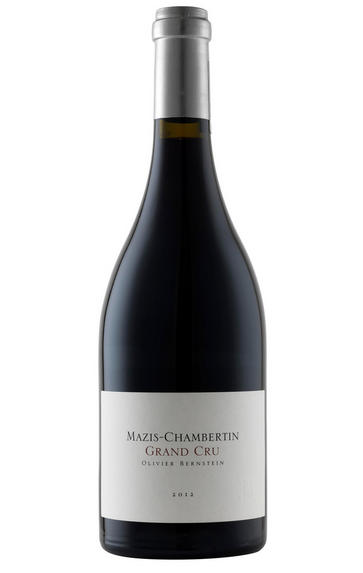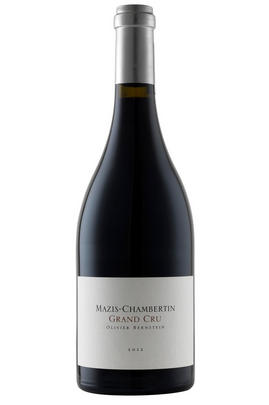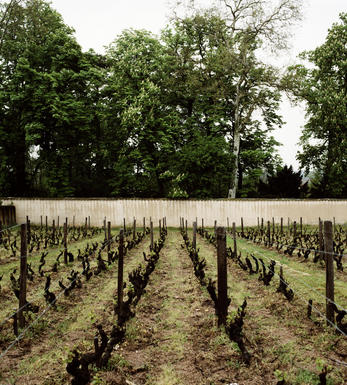
2012 Mazis-Chambertin, Grand Cru, Olivier Bernstein, Burgundy

Critics reviews
burghound.com - Apr 2014
Neal Martin - 30/12/2013
Jancis Robinson - jancisrobinson.com - 13-Jan-2014
About this WINE

Olivier Bernstein
Much has changed in Burgundy, both economically and climatologically, since Olivier Bernstein began his eponymous project with the 2007 vintage. Yet the aim here remains essentially the same: to produce wines of the highest possible quality and to forego nothing in a quest to create elegant, sensual and refined wines that can sit comfortably among the top wines of Burgundy.
It is this quest for perfection that has seen Olivier cease production of two of his Premiers Crus in order to focus on his domaine holding in Champeaux, and the seven Grands Crus which are now well established in the range: Charmes-Chambertin; Mazis-Chambertin; Chambertin Clos de Bèze; Chambertin; Clos de la Roche; Bonnes Mares; and Clos de Vougeot.

Gevrey-Chambertin
Gevrey-Chambertin is the largest wine-producing village in Burgundy’s Côte d'Or, with its vineyards spilling over into the next door commune of Brochon.
Located in the far north of the Côtes de Nuits above Morey-St Denis, classic Gevrey-Chambertin is typically deeper in colour, firmer in body and more tannic in structure than most red Burgundy. The best can develop into the richest, most complete and long-lived Pinot Noir in the world. This is largely thanks to the iron-rich clay soils, though much depends on whether the vineyard is located on either the steeper slopes (Evocelles, Clos St Jacques) or the flatter, richer soils (Clos Prieur, Combottes).
Whereas in the past there have been numerous underperformers in Gevrey-Chambertin exploiting the reputation of this famous village and its iconic Grands Crus, today there are many fine sources to choose from, and overall quality is higher than ever.
Gevrey-Chambertin’s greatest Grand Cru is named after the field of the monk Bertin (Champ de Bertin). In 1847, Gevrey appended the name of this illustrious vineyard, Chambertin, setting a trend for the other principle villages to follow. Le Chambertin may not be quite as sumptuous as Musigny or Richebourg, or as divinely elegant as La Tâche or Romanée-St Vivant, but it is matched only by the legendary Romanée-Conti for completeness and luscious intensity.
In all, Gevrey boasts an impressive nine Grands Crus, with the name of Chambertin retaining a regal omnipresence throughout its finest vineyard names. The other truly great Grand Cru is Chambertin-Clos de Bèze which has the right to sell its wines simply as ‘Chambertin’, and is the only wine allowed to put the Chambertin name before, rather than after, its own. Situated slightly further up the hill, the wines are fractionally less powerful yet full of sensual charm and finesse.
Quality-wise the next best are generally acknowledged to be Mazis-Chambertin and Latricières-Chambertin. The former is incredibly concentrated and very fine, but its structure is a little less firm than Le Chambertin. Latricières is less about power (although it can be explosively fruity) and more about an entrancing silkiness.
Situated slightly higher up the slope, Ruchottes-Chambertin is impressively rich, stylish and slightly angular. The tiny Griottes-Chambertin, which owes its name to the grill-pan shape of the vineyard rather than the wine’s griotte cherry aroma, is lower down the slope and boasts a velvety texture and rich fruit reminiscent of Chambertin itself. It is generally better than the lighter, although wonderfully fragrant Chapelle-Chambertin and Gevrey’s largest Grand Cru, the pure and seductive (if variable) Charmes-Chambertin.
Gevrey also has some outstanding Premier Crus on the south-east-facing slopes above the town. Les Cazetiers and especially Clos St Jacques produce some exceptional wines. Indeed Armand Rousseau, who pioneered domaine bottling here in the 1930s and is still one of the region’s very best producers, often sells his Clos St Jacques for more than several of his Grand Crus.
Drinking dates for these wines vary, but Grand Crus are generally best from at least 10 to 25 years, Premier Crus from eight to 20 years, and village wines from five to 12 years.
- 315 hectares of village Gevrey Chambertin
- 84 hectares of Premier Cru vineyards (20 in all). The foremost vineyards include Clos St Jacques, Lavaux St Jacques, Combottes, Corbeaux, Cherbaudes, Cazetiers.
- 55 hectares of Grand Cru vineyards: Chambertin, Chambertin Clos de Bèze, Latricières-Chambertin, Ruchottes-Chambertin, Mazis-Chambertin, Charmes-Chambertin, Mazoyères-Chambertin, Chapelle-Chambertin, Griottes-Chambertin..
- Recommended producers: Bachelet, Dugat, Esmonin, Mortet, Rossignol Trapet, Rousseau, Serafin, Bernstein
- Recommended restaurants : Chez Guy (good wine list), Rôtisserie du Chambertin (and Bistro)

Pinot Noir
Pinot Noir is probably the most frustrating, and at times infuriating, wine grape in the world. However when it is successful, it can produce some of the most sublime wines known to man. This thin-skinned grape which grows in small, tight bunches performs well on well-drained, deepish limestone based subsoils as are found on Burgundy's Côte d'Or.
Pinot Noir is more susceptible than other varieties to over cropping - concentration and varietal character disappear rapidly if yields are excessive and yields as little as 25hl/ha are the norm for some climats of the Côte d`Or.
Because of the thinness of the skins, Pinot Noir wines are lighter in colour, body and tannins. However the best wines have grip, complexity and an intensity of fruit seldom found in wine from other grapes. Young Pinot Noir can smell almost sweet, redolent with freshly crushed raspberries, cherries and redcurrants. When mature, the best wines develop a sensuous, silky mouth feel with the fruit flavours deepening and gamey "sous-bois" nuances emerging.
The best examples are still found in Burgundy, although Pinot Noir`s key role in Champagne should not be forgotten. It is grown throughout the world with notable success in the Carneros and Russian River Valley districts of California, and the Martinborough and Central Otago regions of New Zealand.


Buying options
Add to wishlist
Description
Mazis-Chambertin (9.10ha) lies at the northern end of the group of Grands Crus, closest to the village of Gevrey-Chambertin, and is divided into two parts of which Mazis-Haut sits on the same rock formation as Clos-de-Bèze, while Mazis-Bas is on slightly deeper soil with some influence from the Combe de Lavaux, both in terms of soil make-up and temperature. It is a predominantly brown soil with a few stones. The underlying rock is in the form of fissured slabs through which the roots are able to penetrate.
Olivier Bernstein buys grapes from Les Mazis- Haut which are blended in with the production of his own vines in Mazis-Bas. The oldest vines are 80-years-old. Very pure, glowing purple colour. The nose shows such beautiful precision, it is almost electric. Arguably the most vibrant of the wines with an excellent fruit acid balance and exceptional persistence.
It shows less of the puppy fat of the vintage but more sophistication. Absolutely magical on the palate with classical distinction and great persistence.
Jasper Morris MW, Burgundy Wine Director The wines of Burgundy – perhaps more than any other region – are a product both of place but also of people. With individual vineyard plots often split amongst countless producers, the terroir expressed in a wine can be unusually specific; equally the style of the winemaker can be readily discerned when tasted against his neighbours.
Back in 2007, Jasper Morris MW – Berry Bros. & Rudd’s Burgundy buyer, who lives in the region for most of the year – heard whispers about a new producer, whose wines were said to be universally impressive. Jasper duly sought out Olivier Bernstein and tasted his portfolio: “It was terrifically exciting to come across a brand-new quality producer in the Burgundy market, and to taste wines of such class from his very first vintage,” says Morris.
“Now, five years on, Olivier has matured into a confident player with his Premiers and Grands Crus wines of the Côte de Nuits.” Since Berry Bros. & Rudd first offered Bernstein’s wines with the 2007 vintage, Olivier’s reputation in the UK and worldwide markets has steadily grown. We are delighted that the 2012 vintage – unquestionably Bernstein’s most refined and well-composed offering to date – will be available to the UK market exclusively through Berry Bros. & Rudd.
wine at a glance
Delivery and quality guarantee